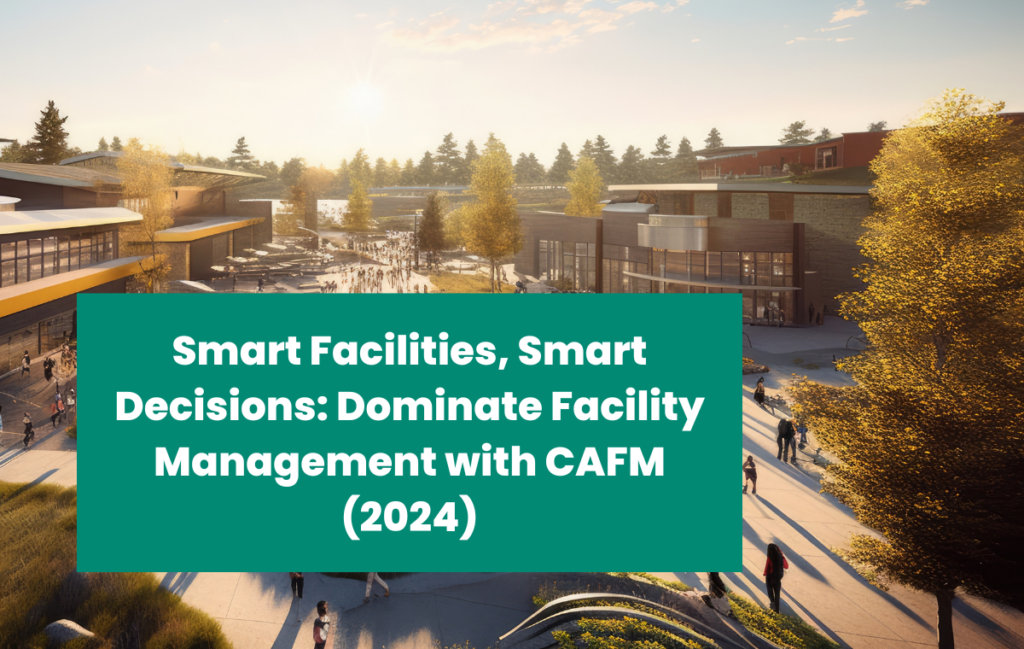Table of Contents

In today’s dynamic landscape of modern facility management, the integration of Computer-Aided Facility Management (CAFM) systems has become a strategic imperative, representing a paradigm shift in how organisations approach the intricacies of maintaining their physical environments. The demands on facility management have evolved exponentially, requiring a sophisticated and comprehensive approach to address the diverse challenges posed by contemporary buildings and workplaces, ultimately transforming them into Smart Facilities that are efficient, responsive, and aligned with the demands of the digital age.
Traditional facility management struggled to keep pace with the evolving needs of today’s occupants. The complexity of handling diverse facilities and the rising demand for instant information exposed the shortcomings of conventional methods. The limitations of traditional approaches became apparent in efficiently meeting the dynamic expectations of modern occupants, showcasing a need for more adaptive and responsive solutions.
Furthermore, events such as the rapid technological advancements in the broader business landscape and the heightened emphasis on sustainability and energy efficiency have significantly influenced facility management strategies. The need for a more integrated and intelligent approach became evident as facilities sought to align with these emerging trends.
CAFM systems emerged as a response to these challenges and events, providing a holistic solution that addresses the multifaceted requirements of modern facility management. By incorporating advanced technologies, data-driven insights, and streamlined processes, CAFM systems have become pivotal in reshaping the way facilities are managed, ensuring a more responsive, efficient, and occupant-centric approach.
The Foundational Principles of CAFM
CAFM’s transformative power lies in its foundational principles, shaping a new era for facility management. These principles tackle the challenges of modern facilities with innovative solutions, going beyond traditional management approaches.
One key principle is efficient data management. Traditional facility management struggles with scattered data sources, causing inefficiencies. CAFM transforms this by consolidating data into a unified platform. This streamlined approach guarantees easy access to all relevant information, from maintenance schedules to asset statuses, ensuring it’s always up-to-date. By simplifying data, CAFM empowers facility managers to make decisions based on comprehensive, real-time insights.
Another vital aspect is intelligent automation. CAFM systems automate manual and repetitive tasks, saving time and resources. This includes tasks like automating work orders, preventive maintenance schedules, and routine reporting. Through automation, facility managers can focus on more strategic activities, boosting productivity and operational efficiency. Intelligent automation ensures facilities not only respond promptly to issues but also anticipate and proactively address maintenance needs.
CAFM brings a holistic approach to facility operations, moving beyond the traditional segmented view of management. Instead of dealing with individual components separately, it considers the entire ecosystem of facility operations. This holistic outlook covers everything from space utilization and occupancy management to energy efficiency and compliance tracking. By recognising the interconnectedness of these aspects, CAFM allows facility managers to implement coherent strategies that enhance the overall performance of the facility.
In essence, these foundational principles redefine facility management by promoting efficiency, intelligence, and adaptability. Streamlined data management, intelligent automation, and a holistic approach collectively empower facility managers to navigate the complexities of modern facilities with agility and foresight. CAFM doesn’t just oversee facilities; it shapes them into agile, responsive entities that effortlessly meet the demands of the modern world.

Defining Smart Facilities
Smart Buildings or Smart Facilities are buildings that leverage information and communication based technology in order to enhance performance and optimise operations with minimal human interference.
Crucially, smart facilities incorporate networked sensors across essential systems such as heating, ventilation, and security. These sensors continuously collect and publish real-time data, providing a comprehensive view of the condition and performance of critical building systems. This integration of technology not only optimises operational efficiency but also facilitates informed decision-making for streamlined facility management.
But what are the benefits?
Smart Facilities offer a myriad of benefits that collectively redefine the landscape of facility management.
First and foremost, they excel in energy efficiency through the integration of automated systems and optimised resource utilisation. Real-time data-driven insights enable the identification and reduction of unnecessary energy consumption, contributing to a more sustainable and cost-effective operation.
Moreover, Smart Facilities significantly cut costs by enhancing operational efficiency and enabling predictive maintenance. Predictive analysis helps in identifying potential issues before they escalate, preventing costly emergency repairs and ensuring a more streamlined budget.
The integration of security systems and real-time threat detection enhances overall security, providing comprehensive protection for occupants and assets.
Smart Facilities also embrace predictive maintenance, utilising sensors to monitor equipment conditions and efficiently allocate resources, thereby extending the lifespan of assets and reducing downtime.
Furthermore, these technologically advanced structures offer flexibility and adaptability, optimising space utilisation and providing an agile infrastructure that can easily adapt to changing needs. Real-time monitoring ensures immediate issue identification and data-driven decision-making, contributing to increased efficiency and proactive problem-solving in facility management.

Internet of Things (IoT) Integration in Smart Facilities
In the evolution of facility management towards Smart Facilities, the integration of the Internet of Things (IoT) serves as a transformative force when coupled with Computer-Aided Facility Management (CAFM) systems. Smart facilities leverage IoT to create an interconnected network of devices, fostering real-time data exchange and intelligent decision-making.
Predictive maintenance becomes a cornerstone of smart facilities through IoT and CAFM collaboration. By embedding sensors in critical assets, CAFM systems harness IoT data to predict potential issues before they impact operations. This predictive capability not only minimises downtime but also enhances the longevity of assets, contributing to the overall intelligence of smart facilities.
Occupancy management in smart facilities reaches new levels of precision with IoT. Smart sensors provide accurate data on space utilisation, enabling facility managers to optimise layouts based on real-time insights. This enhances the overall efficiency of smart facilities, ensuring spaces are tailored to meet the dynamic needs of occupants.
Energy efficiency is a paramount consideration in smart facilities, and IoT integration plays a crucial role. Smart sensors and devices monitor energy consumption in real-time, allowing for precise control over lighting, heating, and cooling systems. This not only reduces energy costs but aligns with sustainability goals, making smart facilities environmentally conscious and energy-efficient.
Key Considerations for Successful CAFM Implementation
Embarking on the journey of CAFM implementation is a strategic move that demands careful consideration of several key factors. The first and foremost consideration is aligning the chosen CAFM system with the specific goals and objectives of the organisation. It’s crucial to assess how well the system’s functionalities match the unique requirements and operational nuances of the business. This ensures that the implemented CAFM solution becomes a tailored and effective tool for achieving organisational success.
Scalability is another critical aspect to ponder during the selection process. As businesses evolve, so do their needs. A scalable CAFM system can grow alongside the organisation, accommodating increased data, users, and functionalities without causing disruptions. This future-proofing approach ensures that the chosen CAFM solution remains relevant and valuable in the long run. Lastly, prioritising user-friendly interfaces is paramount. A CAFM system should empower users with intuitive navigation and functionalities to encourage widespread adoption across the organisation, ultimately enhancing overall operational efficiency.
When embarking on the journey of CAFM implementation, businesses must carefully evaluate the critical aspects of system selection. One of the primary considerations is ensuring that the chosen CAFM system aligns seamlessly with the overarching goals and objectives of the organisation. This strategic alignment ensures that the implemented solution is not just a technological tool but a tailored solution designed to enhance operational effectiveness.
Scalability is equally important, as businesses undergo changes and growth over time. Opting for a CAFM system that is scalable allows for seamless expansion, accommodating the evolving needs of the organisation without causing disruptions. This future-proofing approach ensures that the CAFM solution remains robust and adaptable to the changing landscape of the business. Additionally, prioritising user-friendly interfaces is essential. An intuitive and accessible CAFM system fosters widespread adoption within the organisation, empowering users and contributing to improved overall operational efficiency. These considerations collectively lay the foundation for a successful CAFM implementation journey.

So what now?
In essence, the integration of Computer-Aided Facility Management (CAFM) systems heralds a new era for facility management, propelling us into the age of Smart Facilities. As we navigate this transformative landscape, it is imperative to recognise that traditional approaches have given way to adaptive solutions that cater to the evolving expectations of modern occupants.
The foundational principles of CAFM, marked by efficient data management and intelligent automation, redefine the very essence of how we manage facilities. Embracing Smart Facilities means embracing efficiency, intelligence, and adaptability. The integration of the Internet of Things (IoT) further enhances these capabilities, presenting a realm of possibilities for predictive maintenance, precision in occupancy management, and improved energy efficiency.
As businesses embark on the journey of CAFM implementation, aligning systems with organizational goals, ensuring scalability, and prioritising user-friendly interfaces become paramount. These considerations collectively pave the way for a successful CAFM implementation journey, enabling organisations to harness the transformative potential of Smart Facilities and elevate their facility management practices to unprecedented heights.




